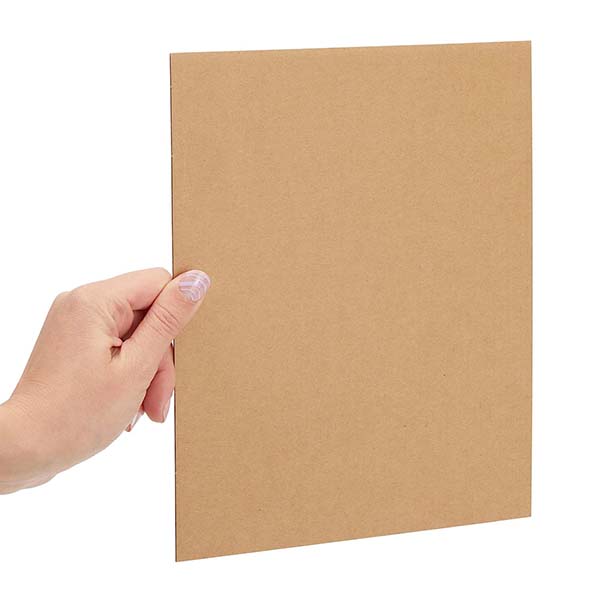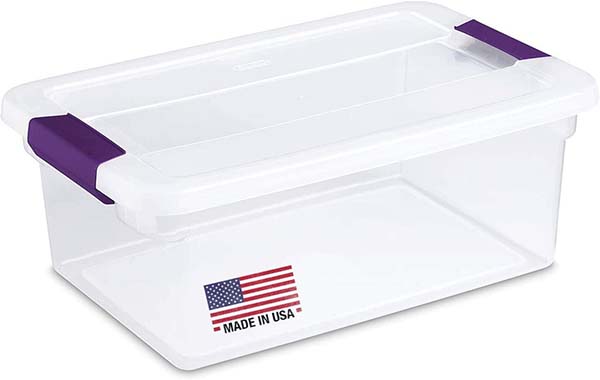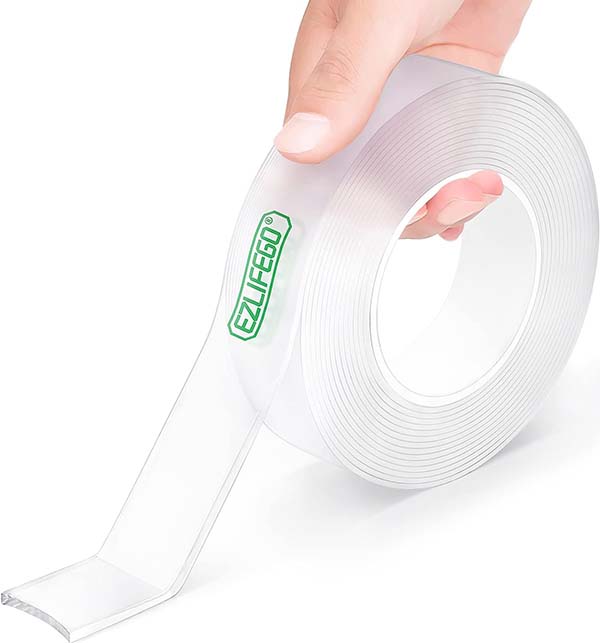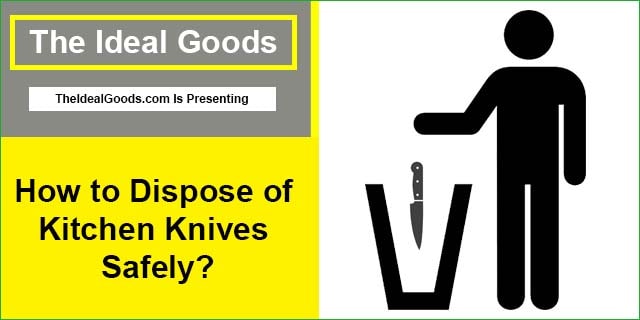Knives are critical tools in the kitchen. It is common for a recipe to require several different types of kitchen knives for various purposes, including slicing, chopping, and spreading.
Having sharp, efficient knives can make cooking significantly easier.
For many reasons, kitchen knives eventually need to be replaced and disposed of, including when they break, bend, or change shape from repeated sharpening.
Safely disposing of knives takes only a few minutes and can prevent serious injuries later.
In this article, you will learn how to safely dispose of your kitchen knives.
Why Do Knives Need to Be Disposed of Carefully?
Unlike most kitchen products, kitchen knives cannot simply be thrown away into a garbage can or recycling bin.
It is important to dispose of kitchen knives as carefully as possible to prevent injuring or cutting anyone who may unknowingly come into contact with the knives.
For example, if someone accidentally throws something away and needs to retrieve it later, they could cut themselves on a knife if it was not disposed of safely.
Improper disposal of knives could even harm animals in rural areas, as they frequently rummage through garbage cans for food.
Finally, throwing a kitchen knife away incorrectly can also result in the knife ripping through the trash bag it was placed in. This is problematic because it could result in injury or simply create a mess.
Why Does the Knife Need to Be Disposed of?
When disposing of your kitchen knives, it is important to understand why they need to be thrown away in the first place.
Is the knife broken?
Is the knife dull?
Or is the knife still in working condition, but you are simply ready for an upgrade or change of style?
Once you understand why you are getting rid of your knife, you can then determine the options you have in terms of its safe disposal.
Does the Knife Still Work?
If the knife you want to dispose of no longer works, it should be carefully recycled or disposed of.
However, if the knife is still in working condition, then you have two options to consider before throwing it away.
First, if the knife is not cutting as well as it did when you first bought it, it is likely just dull.
Depending on how frequently they are used, knives need to be sharpened regularly to maintain their sharpness.
If your knife is simply dull, try sharpening it before throwing it away. Dull knives can either be sharpened at home or taken to a professional sharpener.
If you want to get rid of the hassle of regularly sharpening the knives used in your kitchen, you can try using a good-quality self-sharpening knife set.
Second, if the knife is still working, but is no longer useful in your kitchen, you should consider donating it to a local soup kitchen, shelter, or thrift shop prior to disposal.
How to Donate Kitchen Knives Safely?
Consider donating your fully functional, but unnecessary kitchen knives before recycling or throwing them away.
The knife could work better for someone else’s lifestyle, and they may be happy to take it off of your hands.
You can also ask for a donation receipt to possibly use as a tax write-off for your donation!
When donating kitchen knives, call the shelter, soup kitchen, or donation center ahead of time to make sure that they are able to accept knives.
Once you have determined where to donate your knives, clean and sanitize them to ensure they are hygienic for the next person to use them.
If you have access to a sharpener, you can also consider sharpening them before donating.
Once you have prepared the knives for donation, carefully package them using steps one through four of How To Recycle Kitchen Knives, below, and deliver them to the donation center.
Can Kitchen Knives Be Recycled?
Before throwing away a kitchen knife, you should determine if the knife can be recycled. Recycling knives is beneficial to the environment and many cities recycle kitchen knives.
Specifically, recycled knives need to be taken to a scrap metal facility or to a transfer station where the metal can be reused.
To find out if your city will recycle your kitchen knives, you can contact your local recycling company or dump.
What Materials are Needed to Recycle a Kitchen Knife Safely?
The materials you will need to recycle a kitchen knife include flexible cardboard, such as
- Cereal boxes, brown paper bags, or newspaper;
- Strong tape such as packing tape or duct tape;
- A permanent marker or pen;
- Either a cardboard box or a heavy-duty plastic or metal container that can be tightly sealed;
- And extra newspaper, bubble wrap, packing peanuts, or any other filler material.
Step- 1: Wrapping Process
The first step to properly recycle a kitchen knife is to wrap the knife in several layers of cardboard or newspaper. Two similarly sized knives can be wrapped together by placing the knives on top of one another with their blades pointing in the same direction.
Carefully place the knives in the center of the cardboard or newspaper so that there will be enough paper to fully cover the knives on all sides.
If you have more than two knives to recycle, you can fold over a few layers of cardboard or newspaper and place the additional knives on top of the paper with the blades pointing in the same direction as the knives underneath.
Fold the remaining sheets of cardboard or newspaper over the knives in half, and then fold both sides in around the knives.
Roll the paper with the knives towards the opposite end of the paper until all of the paper is wrapped around the knives. You should no longer be able to feel the knives’ blades or see their tips poking through after they are wrapped.
If you have more than four knives to recycle, you should repeat the wrapping process with the additional knives separately.
Step- 2: Use the Cardboard or Newspaper
After your knives are safely wrapped, you should secure the cardboard or newspaper around the knives with several pieces of tape.
The wrapping should be well-fastened to prevent it from sliding off during transportation. Repeat this step for any other knives you have wrapped.

Step- 3: Label the Wrapping
After taping, label the wrapping with your permanent marker. Write “knives” in large, legible writing.
To specify where the blades are pointing, draw an arrow in the direction of the tips and write “blades”.
Label each of the wrapped packages of knives in case they are separated later.
Step- 4: Seal the Package
After you have labeled the packaging surrounding the knives, carefully place each of your sealed packages into the cardboard, plastic, or metal box you have selected.

Once your sealed knives are safely in the box, fill the extra space with bubble wrap, packing peanuts, or crumpled-up newspaper to prevent the knife from moving around during transportation.
If by any chance the knife was not sealed properly, filling the space will prevent the wrapping from being dislodged.
Finally, seal the box with its lid, if applicable, or packing tape.

Step- 5: Deliver Your Knife
After sealing the box, you are ready to deliver your knife to a local recycling facility. After calling to make sure that the facility will accept your knives, simply drop off the box and let the recycling attendant know what you are delivering.
If you are unable to recycle your knives, then you will need to dispose of them safely into a garbage can following the steps outlined below.
Can Kitchen Knives Be Thrown Away?
If your unwanted kitchen knives cannot be donated or recycled, you can dispose of them carefully into a garbage can.
What Materials are Needed to Throw Away a Kitchen Knife Safely?
The materials you will need to dispose of kitchen knives into a garbage can are similar to the materials required to recycle kitchen knives.
You will need flexible cardboard or newspaper, strong tape, a permanent marker or pen, cardboard or disposable box, and filler material including other trash, newspaper, or bubble wrap.
How to Throw Away a Kitchen Knife?
To safely dispose of a kitchen knife into the garbage, start by following the first four steps to properly recycle kitchen knives, as described above.
First, wrap the knife in several layers of cardboard or newspaper.
Then, securely tape the wrapping around the knives.
Next, label the packaging in case anyone unknowingly comes into contact with your disposed knives.
Finally, place the wrapped and labeled knives into a disposable container, fill the empty space with other disposable material, and seal the container with tape or a lid, if applicable.
Once you have carefully packaged your kitchen knives, you can place them into a garbage bin for disposal.
Key Takeaways for Disposing of Kitchen Knives Safely
Carefully disposing of kitchen knives is important to ensure the safety of anyone who may later come into contact with the knives.
Kitchen knives that are still functioning properly can be donated to local shelters, soup kitchens, or second-hand stores. Many recycling centers, scrap metal facilities, or transfer stations will accept kitchen knives that are damaged or unsuitable for donation.
Finally, if your kitchen knives cannot be donated or recycled, you can throw them away into a garbage can.
When donating, recycling, or throwing away kitchen knives, carefully package them using the method outlined above. It is important to wrap, seal, label, and package your kitchen knives before delivering them to their final destination.
Finally, once you have safely disposed of your full tang or half tang kitchen knives, you will have space for some shiny, new knives!
Read More Reviews of:
- Best Serrated Steak Knives
- Best Non Serrated Steak Knives
- Best Self Sharpening Knife Sets
- Best Kitchen Knife Sets Under $500
- Best Kitchen Knife Sets Under $300
- Best Ceramic Knife Set
- Best Japanese Chef Knife Under $200
- Best Cleaver Knife Under $50
- Best Japanese Cleaver Knife
- Best Damascus Steak Knife
- Best Knives for Cutting Ribs
